PixelBlocks [1] are small plastic blocks that are representative of pixels. They can be linked together to form both 2-D and 3-D shapes, and come in 20 different colors. They are made by PixelBlocks Inc.
PixelBlocks [1] are small plastic blocks that are representative of pixels. They can be linked together to form both 2-D and 3-D shapes, and come in 20 different colors. They are made by PixelBlocks Inc.
PixelBlocks are roughly 3/8" (0.9 cm) square and translucent. [2] Their edges are grooved so that the blocks can be linked to each other, much like a jigsaw puzzle. There are three ways to link the blocks: linking two pieces so their edges line up (a side lock), linking them so, and putting one block on top of the other (peg-and-hole). These three types of link allow for both 2-D and 3-D structures to be created.
PixelBlocks were introduced at the American International Toy Fair on February 26, 2003. [3] They had strong early sales, with 40% of retail accounts placing reorders. [4] The president of PixelBlocks, Aaron Rincover, was "quite pleased" with early sales. PixelBlocks was the recipient of Child's “Best Toys of the Year” award and named a Toy Wishes’ “Great Innovation”. It also obtained a “Toy Tips Trusted” five-star rating, a Creative Child “Seal of Excellence” award, and a “Seal of Approval” honor from the National Parenting Center. [5] The toy is no longer in production.

The Intellivision is a home video game console released by Mattel Electronics in 1979. The name is a portmanteau of "intelligent television". Development began in 1977, the same year as the launch of its main competitor, the Atari 2600. In 1984, Mattel sold its video game assets to a former Mattel Electronics executive and investors, eventually becoming INTV Corporation. Game development ran from 1978 to 1990, when the Intellivision was discontinued. From 1980 to 1983, more than 3.75 million consoles were sold. As per Intellivision Entertainment the final tally through 1990 is somewhere between 4.5 and 5 million consoles sold.

A liquid-crystal display (LCD) is a flat-panel display or other electronically modulated optical device that uses the light-modulating properties of liquid crystals combined with polarizers. Liquid crystals do not emit light directly but instead use a backlight or reflector to produce images in color or monochrome.

A toy or plaything is an object that is used primarily to provide entertainment. Simple examples include toy blocks, board games, and dolls. Toys are often designed for use by children, although many are designed specifically for adults and pets. Toys can provide utilitarian benefits, including physical exercise, cultural awareness, or academic education. Additionally, utilitarian objects, especially those which are no longer needed for their original purpose, can be used as toys. Examples include children building a fort with empty cereal boxes and tissue paper spools, or a toddler playing with a broken TV remote control. The term "toy" can also be used to refer to utilitarian objects purchased for enjoyment rather than need, or for expensive necessities for which a large fraction of the cost represents its ability to provide enjoyment to the owner, such as luxury cars, high-end motorcycles, gaming computers, and flagship smartphones.
JumpStart was an educational media franchise created for children, primarily consisting of educational games. The franchise was developed by JumpStart Games and expanded beyond games to include workbooks, direct-to-video films, mobile apps, and other media. It was officially launched on March 10, 2009, offering a blend of educational content and entertainment experiences.

The LeapPad is a range of tablet computers developed for children, specifically of the ages 3-9. Various models of the LeapPad have been developed by LeapFrog Enterprises since 1999.
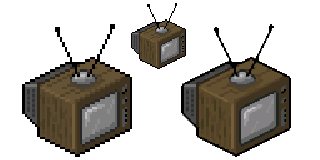
Pixel art scaling algorithms are graphical filters that attempt to enhance the appearance of hand-drawn 2D pixel art graphics. These algorithms are a form of automatic image enhancement. Pixel art scaling algorithms employ methods significantly different than the common methods of image rescaling, which have the goal of preserving the appearance of images.
Techno Source is a handheld electronic game and TV game company selling electronic toys, games and learning aids. Based in Hong Kong with an office in New York City, it is a privately owned company founded in 2000 by Wayne Nathan and Rich Migatz. In April 2011, Techno Source was acquired by Li & Fung.
BabyCenter is an online media company based in San Francisco, New York City, Chicago, and Los Angeles that provides information on conception, pregnancy, birth, and early childhood development for parents and expecting parents. BabyCenter operates 9 country and region specific properties including websites, apps, emails, print publications, and an online community where parents can connect on a variety of topics. Users of the website can sign up for free weekly email newsletters that guide them through pregnancy and their child's development.
Toy advertising is the promotion of toys through a variety of media. Advertising campaigns for toys have been criticized for trading on children's naivete and for turning children into premature consumers. Advertising to children is usually regulated to ensure that it meets defined standards of honesty and decency. These rules vary from country to country, with some going as far as banning all advertisements that are directed at children.
A smart toy is an interactive toy which effectively has its own intelligence by virtue of on-board electronics. These enable it to learn, behave according to preset patterns, and alter its actions depending upon environmental stimuli and user input. Typically, it can adjust to the abilities of the player. A modern smart toy has electronics consisting of one or more microprocessors or microcontrollers, volatile and/or non-volatile memory, storage devices, and various forms of input–output devices. It may be networked together with other smart toys or a personal computer in order to enhance its play value or educational features. Generally, the smart toy may be controlled by software which is embedded in firmware or else loaded from an input device such as a USB flash drive, Memory Stick or CD-ROM. Smart toys frequently have extensive multimedia capabilities, and these can be utilized to produce a realistic, animated, simulated personality for the toy. Some commercial examples of smart toys are Amazing Amanda, Furby and iDog. The first smart-toy was the Mego Corporation's 2-XL robot (2XL), invented in the 1970s

Stevanne Auerbach, also known as Dr. Toy, was an American educator, child development expert, writer and toyologist. She was best known for being an expert on as well as an advocate of toys, play and the toy industry. After more than fifty years in the field of toys, she was named one of seven Wonder Women of Toys in 2007 by Women in Toys and Playthings magazine. She was a frequent guest speaker on toys and play for all ages at industry, professional, parent and public meetings. She made several public appearances each year to promote her causes, which include building greater awareness in parents of their essential role as play tutors for their children, the educational, and many other benefits of play, and to encourage the enhancement of play value and high standards of quality, safety, and protection of creativity in toys within the toy industry.
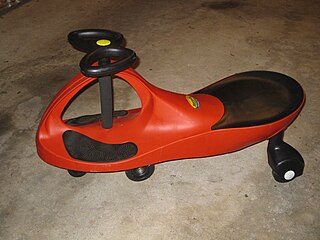
The PlasmaCar is a plastic ride-on toy car designed for children, made popular by Canadian toy distributor PlaSmart. The PlasmaCar can be propelled by wiggling the front steering wheel which is attached to two pivoting wheels touching the ground. It harnesses the natural forces of inertia, centrifugal force, gravity, and friction in order to drive the car forward and backward. It does not require a power source such as batteries, fuel, pedals, or gears - it simply runs on the child's ability to wiggle the steering wheel. It can be operated indoors and/or outdoors, though it works best on a smooth, flat surface.

Daniel S. Schechter is an American and Swiss psychiatrist known for his clinical work and research on intergenerational transmission or "communication" of violent trauma and related psychopathology involving parents and very young children. His published work in this area following the terrorist attacks on the World Trade Center in New York of September 11, 2001 led to a co-edited book entitled "September 11: Trauma and Human Bonds" (2003) and additional original articles with clinical psychologist Susan Coates that were translated into multiple languages and remain among the first accounts of 9/11 related loss and trauma described by mental health professionals who also experienced the attacks and their aftermath Schechter observed that separation anxiety among infants and young children who had either lost or feared loss of their caregivers triggered posttraumatic stress symptoms in the surviving caregivers. These observations validated his prior work on the adverse impact of family violence on the early parent-child relationship, formative social-emotional development and related attachment disturbances involving mutual dysregulation of emotion and arousal. This body of work on trauma and attachment has been cited by prominent authors in the attachment theory, psychological trauma, developmental psychobiology and neuroscience literatures
The Oppenheim Toy Portfolio is a nationally recognized independent consumer review of children's media. It was founded in 1989 by child development authors Joanne Oppenheim and her daughter Stephanie Oppenheim. The newsletter is published quarterly and have held an annual series of awards that have gained attention in the industry. They have spoken on children psychology/behavior, toys, and child media on OPRAH, CNN, NBC Nightly News, ABC World News Tonight, MSNBC, Lifetime, and both are Contributors to NBC's TODAY Show.
Dr. Eitan Schwarz is an adult, child, and adolescent psychiatrist. He is a graduate of Johns Hopkins University and has a psychiatric practice in Skokie, Illinois. He published the book Kids, Parents, and Technology in 2010. He's currently on the faculty at Northwestern University's psychiatric department, and his research interests include PTSD, digital media in play therapy and the consumption of media by children and families.
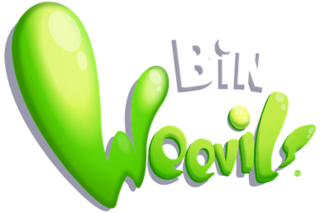
Bin Weevils was a British MMORPG involving a virtual world containing a range of online games and activities.

Toca Boca is a Swedish children's mobile video game developer. The company is owned by Spin Master and is based in Stockholm, Sweden.
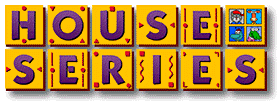
Early Learning House or simply the House Series is a collection of four main educational video games and two compilations for the Windows and Macintosh platforms, developed by Theatrix Interactive, Inc. and published by Edmark software. Each different game focuses on a particular major learning category with selectable skill settings for preschooler, kindergarten and elementary learners. Millie's Math House (1992) on mathematics, Bailey's Book House (1993) on language, Sammy's Science House (1994) on science, and Trudy's Time and Place House (1995) on history and geography. A spin-off, Stanley's Sticker Stories (1996), sees players create animated storybooks with the series' characters. Millie & Bailey Preschool and Millie & Bailey Kindergarten each contain the combined activities from two of the four software products. In addition the programs can be configured by an adult mode to suit students with special needs. Most of the activities in every game have two modes, one to allow learners to explore and try it out for themselves and the other for learners to follow specific tasks set by the game characters. Learners also have the option to print pictures of creative activities and record sounds in phonics activities. Later the games were re-developed by Houghton Mifflin Harcourt Learning Technology and re-published by The Learning Company with newer graphics and additional activities.
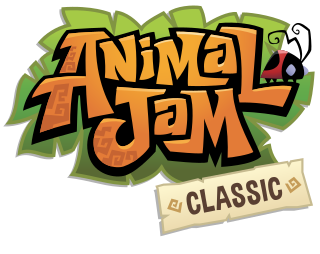
Animal Jam Classic, formerly known as Animal Jam, is a massively multiplayer online game that is developed by WildWorks and recommended for kids up to the age of 12. It was launched in 2010, in collaboration with the National Geographic Society. As of late 2020, there were 3.3 million monthly active users and a lifetime total of 130 million registered players in 200 countries across both Animal Jam Classic and Animal Jam.
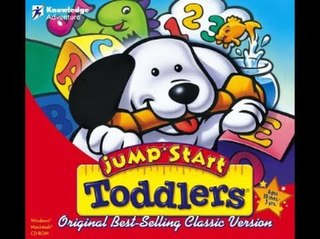
JumpStart Toddlers is a 1996 educational video game, the fourth within the JumpStart franchise. An enhanced version was released in 2000.